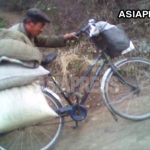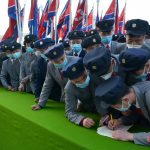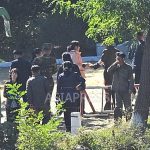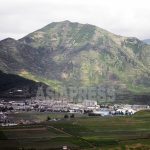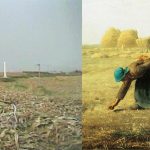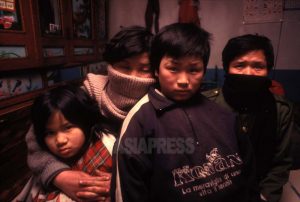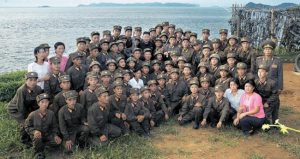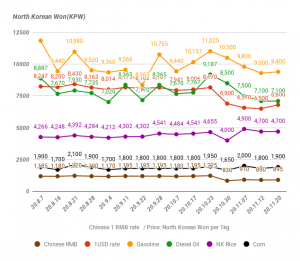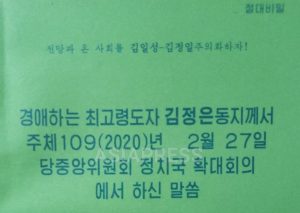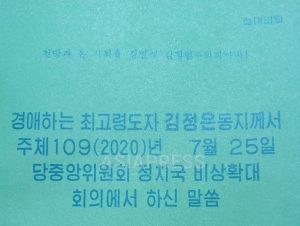The Daily Life of North Koreans
2014/April/05
Written by PAEK Chang-ryong, a defector reporter
Handcart porters call themselves "a tailless ox".
In North Korea, where private car and truck ownership is beyond the reach of ordinary citizens, and fuel is a precious commodity, the handcart is a considered a basic necessity for everyday life. These oversized wheelbarrows are utilized in various daily activities, employed in moving large amounts of water, firewood or coal bricks.
Cargo or luggage transportation is considered by many North Koreans to be a good method of earning a wage in difficult times. In North Korea, these handcarts are called sonsure (손수레), while the porter who pulls the cart is known as a sonsure-kun (손수레군), or chim-kun (짐군).
These "Tailless Oxen" can be seen everywhere in the country, particularly in and out of the marketplaces and railway stations where there is, unsurprisingly, a high demand for their labor.
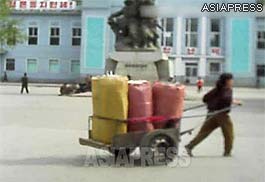 A female porter pulls a handcart loaded with overflowing sacks. (In front of Hyesan Railway Station. Hyesan, Ryanggang Province. October, 2013) ASIAPRESS |
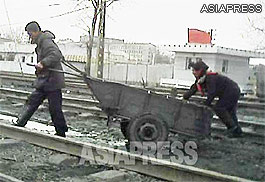 A man and woman pull a large handcart across railway tracks. The man has lashed his body to the cart with a rope so as to pull the cart more effectively. (South Pyongan Province. March, 2013)ASIAPRESS |
The handcarts most commonly spotted on the streets in North Korea are equipped with rubber tires the like of which are also used on 2-ton trucks. Having said this, there are various kinds of handcarts to be seen, wheels wobbling precariously under a heavy load of necessities. The smaller versions have wheels salvaged from discarded bicycles. Others, often put to use as mobile street stalls, move along on wooden wheels, the fact is that the majority of these rickety carts are put together by hand.
For those entrepreneurs wishing to join the handcart business, it is required that each "Tailless Ox" be registered and have authorization from the local government. Don't let this put you off, however, as there are a considerable number of unlicensed porters engaged in the business.
From time to time, the authorities are known to launch crackdowns to weed out the unlicensed freewheelers from the street. Those picked up during the crackdowns risk having their carts confiscated, whisked away on the back of a government truck. Usually, heavy verbal sparring between the officers confiscating, and the porters, for whom the carts are their sole source of income, marks these incidents. Some porters attempt to resolve the problem by resorting to bribes. It is also not unknown for officers to directly ask porters for a fee for overlooking their misdemeanors.
In the picture above(right), a man and a woman transport a load of coal bricks across a set of railway tracks. According to our North Korean reporter, the compensation they earn from transporting the load 150 meters (492 ft) is 6,000won (around 80 US cents at the time the information was gathered). Our reporter who took this film explained that some porters bring goods to the door of households located in tall apartment buildings. The fee for such home delivery is around 500 won per a bucket.
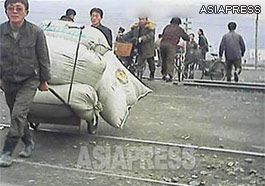 A man is pulling a fully loaded handcart across the railway tracks. (Pyongsong. South Pyongan Province. March, 2013)ASIAPRESS |
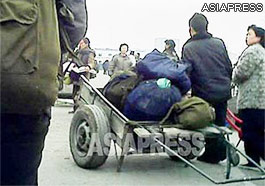 A female customer (right) negotiates with the porter (left) on the price for his services (Pyongsong. South Pyongan Province. March, 2013) ASIAPRESS |
The metal frame of the more sturdy handcarts are welded tightly together and made to stand up to the most strenuous of jobs. Even the smallest carts are able to survive under towering loads. Porters refer to themselves as "tailless oxen," it is hardly surprising when we see them scuttling from home to home and business to business with load after load, each day.
In North Korea, "porter business" is also popular for university students in a part time capacity. Whenever they have free time, they sweat to earn a bit of extra money. Some of these part time students are hired by authorized handcart owners, others take whatever is available, working for unauthorized private porters when possible.
In the evening, as the sunsets on the Pyongyang railway station, it is a common to come across students pulling handcarts for passengers arriving home. Most of these students are from the universities near the station including the prestigious Kimchaek University of Technology.
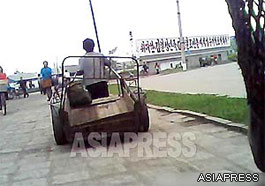 A female porter is pulling a large handcart. The slogan-board on the right reads, "Make the Great Kim Il-sung's nation and Kim Jong-il's Korea revered by the world!" (Chongjin. North Hamkyung Province. September, 2013) ASIAPRESS |
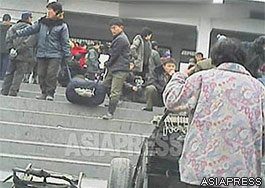 A man and woman emerge from the entrance gate of the station, each grasping a strap of a bag bursting at the seams. The railway station is usually the best place for porters to solicit customers. (Pyongsong Railway Station. South Pyongan Province. September, 2013) ASIAPRESS |
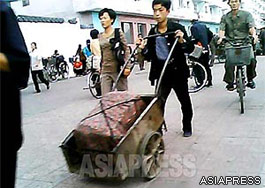 This is a smaller size handcart with thin wheels. Part time workers usually use this kind of handcart. (Pyongsong. South Pyongan Province. September, 2013)ASIAPRESS |
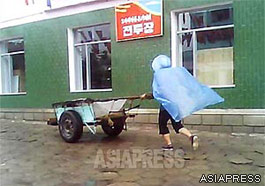
|
A red signboard behind the woman pushing the handcart in the picture above reads, "The battle station for winning the Three-Revolution Red Flag".
The "Three Revolutions", advocated by the late Kim Il-sung in 1970s, was implemented to further progress in the fields of thought, technology and culture and take North Korean socialism "toward victory".
Forty years have passed since the cry was first heard for the "Three-Revolutions," today people are striving for themselves against many hardships. One of the ways they are doing this is by making use of what they have in plying their trade using hand-made handcarts.
*** Rimjin-gang
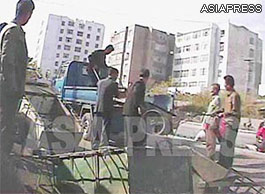 The local authorities from time to time launch crackdown operations against unauthorized porters. In this photograph, handcarts are being confiscated and taken away on the back of a blue truck by the local government. (Haeju.South Hwanghae Province. October, 2008) ASIAPRESS |
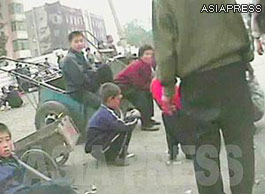 Porters soliciting customers near the Sariwon Railway Stations. (Sariwon. North Hwanghae Province. October. 2008, Taken by Sim Ui-chun) ASIAPRESS |
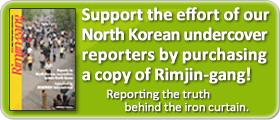
* Editor's notes on North Korean reporters
ALL REPORTS >>>
ARCHIVE(pdf) >>
